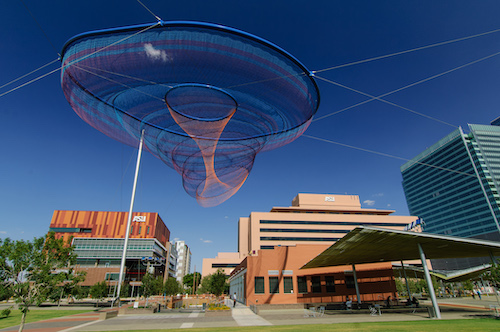Declaring independence from state revenue
Arguably the boldest change at ASU was an overall rethinking of how the university was going to pay the bills. Arizona, like Michigan, is a place where the state government is gradually cutting funding for higher education, so ASU decided to fundamentally recreate its business model to reduce its dependence on the state. Today, state funding only accounts for about 9 percent of ASU’s total budget. (It’s about 16 percent at UM-Dearborn.) Even so, ASU’s yearly tuition and fees, which average between $11,000 and $12,000 in 2019, are the least expensive out of Arizona’s three state universities. Searle refers to this as the “enterprise model” for universities, where they aspire to have total, independent control of their financial destinies, much like private-sector businesses. At ASU, they’ve been able to achieve these results by aggressively committing to growing other revenue streams, like research, research-fueled enterprise and philanthropy.
Big-target, small-donor philanthropy
ASU is not a university with a long history of large capital campaigns. In fact, Searle says they’ve had exactly two in the history of the institution. Their current “Campaign ASU 2020” has a lofty goal at $1.5 billion (a number they’ve already surpassed) and a unique approach that makes small donors a priority. “Our real goal was building a culture of philanthropy within the institution, because we knew we were never going to see the state invest at the levels that they used to. We had to find new income, and philanthropy is one of those ways,” Searle explains. Campaign ASU 2020 has to date drawn support from 110,000 different donors, 25,000 of whom are new donors to the institution. Ninety percent gave $100 or less.
Making access the mission
Perhaps the most interesting part of ASU’s transformation is the adoption of a governing charter that makes diversity and inclusion a stated part of the university's mission. The consequence of this, Searle says, is that improving access for traditionally underserved groups is not just a rhetorical talking point, but a driving force that shapes decisions — and even a metric by which success is measured. The numbers speak for themselves. Out of all first-year in-state students, 52 percent are students of color. And they’ve made similar improvements to access for learners from lower-income families. ASU has made that happen, in large part, by increasing its own need-based aid (the state of Arizona has no need-based student aid program). Today, around 20 percent of ASU’s tuition dollars, around $450 million, are devoted to need-based aid for students. And every Pell-eligible student who qualifies for admission gets funding for eight semesters of tuition, fees, room and board, and books — plus 20 hours of on-campus employment. They’re all also assigned a mentor. Even ASU President Michael Crow is assigned two students a year.
Letting the student experience drive policy
Universities are melting pots of interests and different constituents, including students, faculty, staff and the public we serve. Searle says one of the fundamental parts of the culture change at ASU has been switching to thinking like a student-centric organization, instead of a faculty-centric organization. “For example, when you schedule classes, that has to meet the students’ needs, not the faculty needs. And you have to make sure students can get the classes they need to graduate on time.” As a result, ASU has a guarantee that students will have access to any class they need in the semester they need it.
Use data-backed solutions, but don’t let metrics get in the way of good ideas
ASU uses plenty of data to guide action at the university. One of the most interesting examples is an early intervention system for first-year students, in which a big-data algorithm is run daily to assess whether a student is at risk of withdrawing or failing. If a student’s “risk score” changes at any time, there’s an intervention the very next day. But Searle says the university isn’t overly focused on measuring everything either — especially at the expense of deploying what they think are good ideas. For example, they’ve implemented a variety of programs to boost student success — the sheer number of which makes it hard to measure the impact of any one program. “I get asked a lot, ‘How do you know everything works here?’ Well, we don’t. We only know the cumulative effect.” Searle says, to him, the bigger risk lies in depriving a student of a service that might help them while you spend time figuring out whether it will. So his advice: Don’t be afraid to throw a great idea at the wall and see if it sticks. “The cost of trying and failing are not great.”




